Top 10 Vegetarian Indian Thali Meals To Try In 2023
Introduction: The Diverse World of Indian Thalis

The Indian Thali, with its diverse range of flavors and tastes, is loved by many. For those familiar with Indian cuisine, it is known that there are various types of Thalis available depending on the region of India. However, for those new to Indian food, it is important to note that there is no singular type of Indian Thali, and each region has its own distinct version.
While certain items such as Rice and Pickle are commonly found in most Indian Thalis, each Thali has its own distinctive feature that sets it apart and gives it a regional identity. In this post, I will be sharing the unique characteristics of each Indian Thali.
As a vegetarian, my knowledge is limited to vegetarian Thalis of India, and therefore, I will be focusing solely on them in this post.
What is an Indian Thali?
Thali refers to a circular plate with raised edges, typically made of metal, on which food is served. Steel and brass are the most commonly used materials for Thalis these days, although copper and experimental clay Thalis can also be found in some places. In the past, Gold and Silver Thalis were used by the wealthy, as well as Gods and kings, and they may still be used today.
Food is served on the Thali, with small bowls called Katoris placed on it. This allows for a sample of the entire menu to be served in one go, all in one place.
Ingredients
Indian Thali is supposed to have the 6 tastes that Ayurveda prescribes. The six tastes being:
- Salt
- Sweet
- Sour
- Bitter
- Spicy
- Astringent
An ideal Indian Thali is one that harmoniously balances six tastes. In addition, the colors of the dishes are also balanced, making the Thali as vibrant and diverse as the country of India itself. You will notice an array of colors such as reds, greens, browns, yellows, and whites in the dishes. The aromas from different dishes blend together to create an explosion of flavors that appeal to all five senses.
The grains used in a Thali are often based on what is locally available, making it an excellent opportunity to try local cuisine. Rice, Raita, and Salad are typically included in all Indian Thalis.
In the Western world, meals are often served course by course. However, in Indian Thalis, one can choose to eat in any order they prefer, though purists may recommend a specific order.
To complement the Thali, a Lassi or Chhaas is an ideal choice, depending on the weather.
Join me as we take a tour of India through its diverse Thalis.
1. Rajasthani Thali
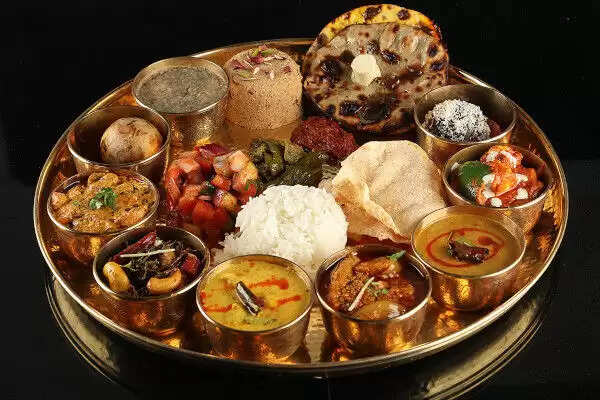
While it may seem biased, I must confess that the Rajasthani Thali is my personal favorite among all Indian Thalis. It is a delightful blend of dry and rich flavors that are enhanced by the generous use of desi ghee. Some distinctive dishes that one must try in a Rajasthani Thali include:
- Dal Bati Churma – a true blue desert food
- Gatte ki Subzi – when the vegetables are not easily available, gram flour is used to make curry
- Ker Sangri – This is one indigenous wild plant that grows across the desert. You get both Sabzi and pickle from Ker Sangri
- Bajre ki Roti – Roti made of Bajra, usually drier than wheat roti, so eaten with a layer of Desi Ghee
- Lahsun ki Chutney – Garlic Chutney
- Khichdi – A multi-grain khichadi with Wheat, Bajra & Jowar
- Kadhi – although you find it in many menus, each region has its own recipe
- Roasted Papad
- Ghevar – a traditional Rajasthani sweet dish, usually available in monsoon season
2. Bengali Vegetarian Thali
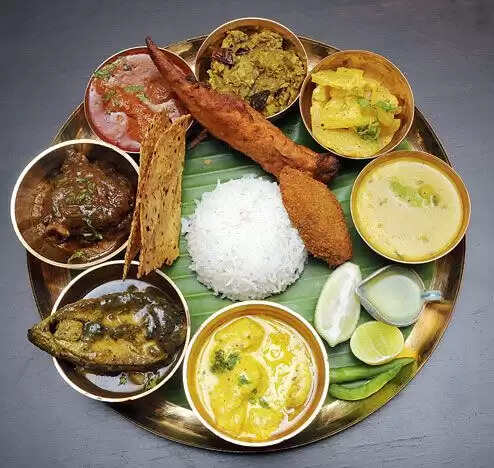
The terms "vegetarian" and "Bengali" may seem contradictory at first, but to my pleasant surprise, there are plenty of vegetarian options available. Bengali cuisine offers an extensive range of flavors and choices for vegetarians. It is worth noting that Bengalis tend to incorporate a hint of sweetness in their dishes, with the exception of rice.
So, what makes a Bengali Thali unique?
- Mishto Doi – Told you everything is sweet here & the sweet set curd is the most celebrated part of Bengali meal.
- Baingan Bhaja – Brinjal or Aubergine fries
- Aaloo Posto – Potato cooked with poppy seeds, a combination you find only in Bengal
- Luchi – It is like a small-sized Poori, but made with Maida, and tastes a bit different
- Rasgulla or Roshogulla – No Bengali Thali is complete without this favorite sweet of Kolkata.
- Daal, seasonal vegetables cooked in mustard oil and rice complete the menu.
3. Goan Vegetarian Thali
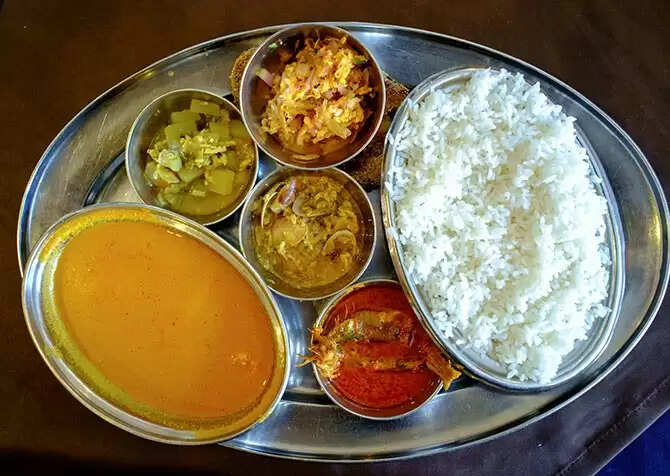
Although it may not be effortless, finding a vegetarian Thali in Goa is possible at many places. Simply eliminating all non-vegetarian items from a Goan Thali would leave you with rice, salad, and sol kadi.
To enhance the Thali, one can include shallow-fried Phodi, soaked in semolina, made from local vegetables such as banana, roots, and breadfruit. This crispy element is unique to Goa.
Furthermore, adding a seasonal vegetable in coconut curry would complete the Thali.
Daali Toye – a watery and rather bland version of the usual Daal.
Add Tambri Bhaji or Patal Bhaji usually made with red leaves
That is your Goan Vegetarian meal.
4. Gujarati Kathiawadi Thali
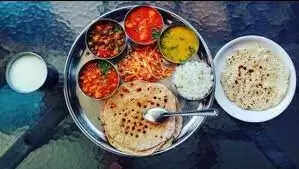
Similar to Indian cuisine, there are numerous versions of the Gujarati Thali, with the Kathiawadi Thali being especially renowned. Like the Bengali Thali, Gujarati cuisine is also known for its sweet undertones. Interestingly, both the eastern and western regions of India share a fondness for sweetness. However, Gujarat's cuisine is also known for its distinct garlic flavor, with many dishes featuring the prefix "Lehsunia," indicating a generous amount of garlic.
- Tamatar Shev ki Sabji – This is what defines a Gujarati Thali for me.
- Papad ki Subji – yes you can make a curry from Papad too
- Undhiyo – a version of Khichadi
- Kadhi
- Dhokla or Khandvi shine with their bright yellow color
- Small sized Rotis or Bhakris made of Bajra accompany the meal.
- Desi Ghee and Jaggery are used to give a finishing touch to the Gujarati Kathiawadi Thali
5. Punjabi Thali
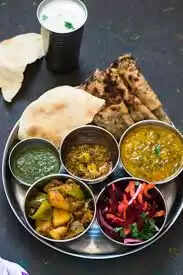
What I am going to present here is my interpretation of a Punjabi Thali, which happens to be my personal favorite and one that I yearn for. The ideal season to relish this meal is during the winter months while basking in the warm sunshine. While the menu may be limited, as the saying goes in Punjab - "Sawa Lakh se Ek ladaun," or "one of my dishes is worth more than a full thali of yours." So, the contents of this Punjabi Thali include:
- Sarson ka Saag with a thick layer of desi ghee floating on it.
- Freshly made Makki ki Roti with a layer of what else, Desi Ghee.
- Raddish or Mooli dipped in vinegar or maybe lime juice
- A bit of raw onion
- Mango Pickle
- Chunks of jaggery or Gud to end the meal
6. Malwa Thali from Madhya Pradesh
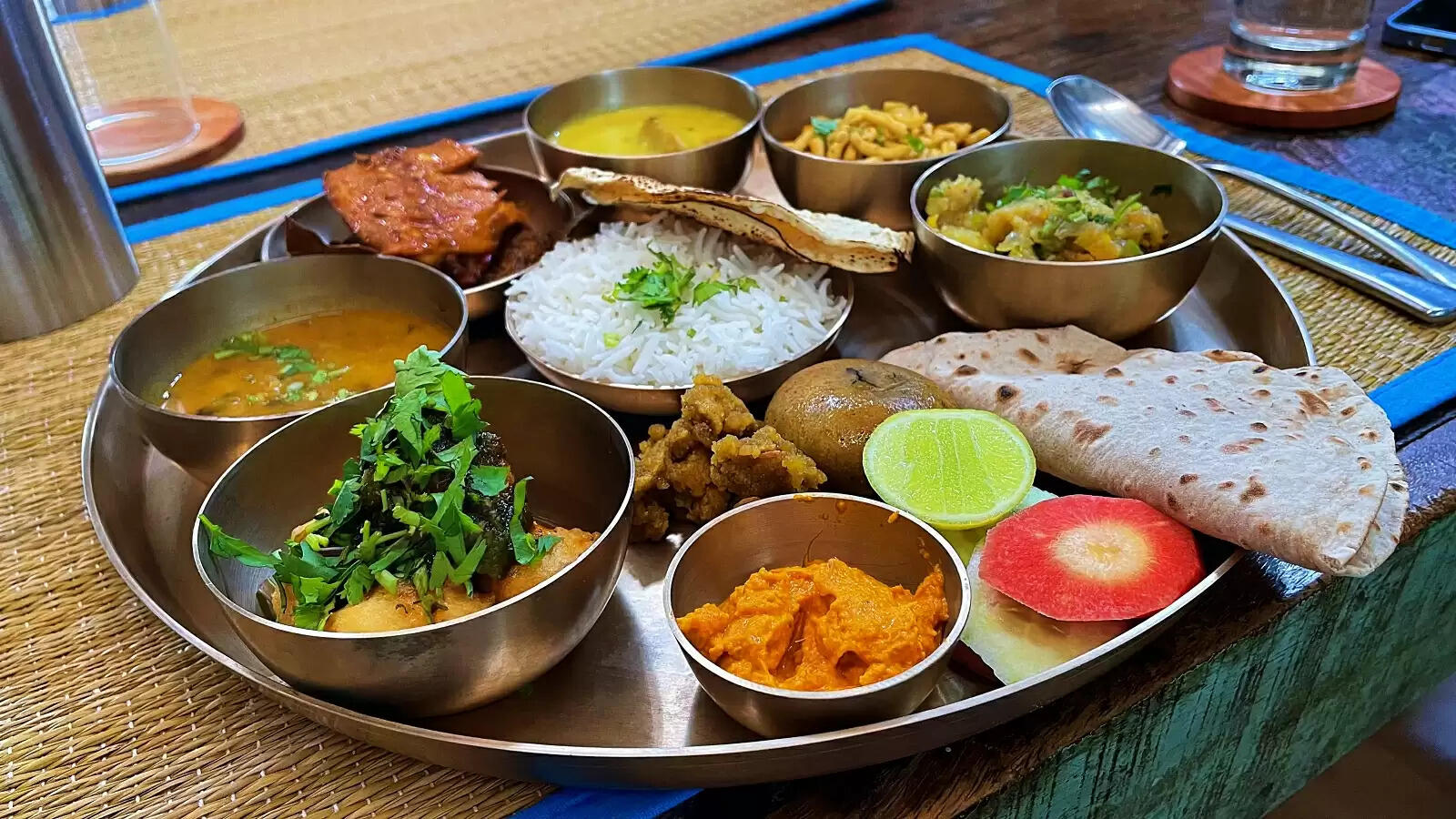
This Thali hails from Mandu, the former capital of Malwa, in the heart of India. It is not a widely known dish and may require some patience to acquire a taste for it. When I first tried the key ingredients of this dish, Paaniya and Daal Bafna, I wasn't immediately fond of them. However, with time, their unique flavors grew on me.
Paaniya is made from corn flour or Makki ka Aata, while Bafna is made with Toor Daal. Traditionally, they were roasted on cow dung in a Chulha, an open fire. The dish was then covered with leaves and cooked. Nowadays, they are typically baked in a tandoor or clay oven.
This Malwa Thali consists of these two star dishes, along with daal, rice, seasonal vegetables, kadhi, salad, and a sweet dish.
7. Andhra Thali
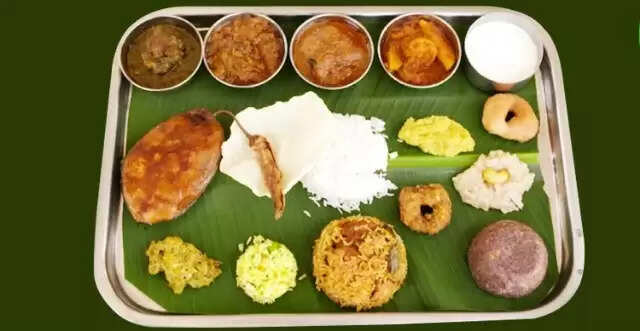
When it comes to spiciness, Andhra cuisine is arguably the spiciest among all Indian cuisines. Its dishes are often characterized by a layer of fiery red from the use of Guntur chillies, particularly in sambhar and rasam. Along with the shining white rice, the bright curries complete an Andhra Thali, which typically includes:
- Parripu Podis – Dry lentil-based chutney powders. You can add them to any other items, after mixing it with ghee or Til oil.
- Gongura – this is sour leave that you get only in Andhra and hence only in Andhra cuisine. You may find it as part of Dal or as chutney or as part of a side dish. Personally, this is the high point of Andhra meal for me.
- Baingan Subzi – Many regions of India have Brinjal as part of their special fair, Andhra is also one of them.
- Avakai – An Andhra style mango pickle, true to the cuisine it is spicy.
8. Kashmiri Thali
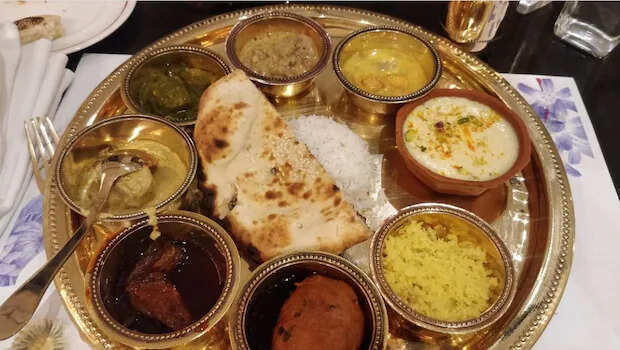
To get a vegetarian Kashmiri Thali, it is usually necessary to place a custom order in most of Kashmir. However, during my visit to Gulmarg, I was able to try a vegetarian version. Some of the unique components of this Thali were:
- Nadru or the Lotus stem crisps. They can also come in the form of stuffed Kebabs.
- Kashmiri Dum Aaloo – The whole potato cooked in curry is a defining element of Kashmiri cuisine for vegetarians like me.
- Haak – lightly sautéed fresh greens that have a tinge of the bitter taste
- Walnut Chutney – Walnut comes from Kashmir; you find it everywhere including in the furniture and souvenirs made from walnut wood. In your Kashmiri meal, taste it as tangy walnut chutney.
- Kashmiri Roti – Tandoori roti usually infused with spices
- Phirni – threadlike noodles cooked in milk with nuts on top is a soothing sweet dish, save some space for it.
- Raita with Gheeya or bottle gourd is popular in Kashmir
- Kahwah – No matter what you eat in Kashmir, finish it with a cup of saffron infused, nut loaded kashmiri kahwah
9. North Karnataka Thali
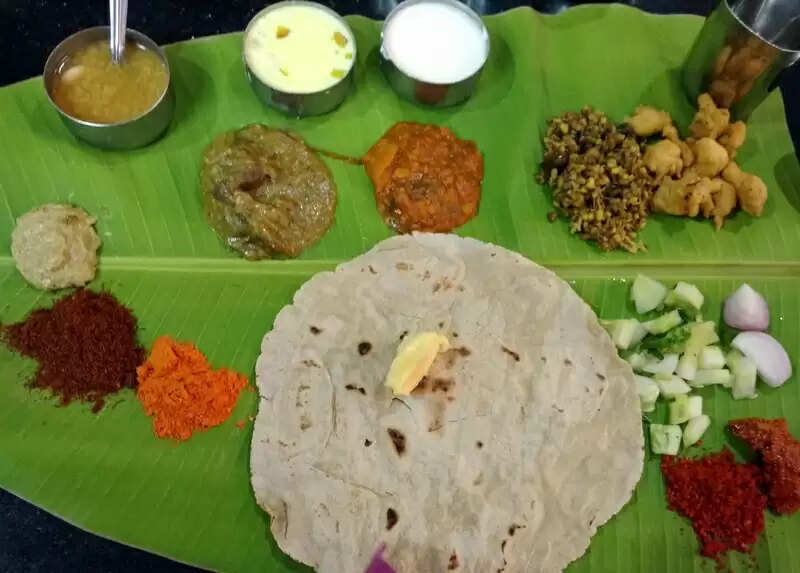
The Thali I am about to describe brings back memories from my time at Infosys. Served on a banana leaf, it was so popular that one had to wait in a queue to enjoy it, but it was definitely worth the wait.
The meal is a humble one, consisting of freshly made Jowar Rotis and Baingan Subzi, and was served on a banana leaf during my time at Infosys. While rice and sambhar were provided to complete the meal, they were not the star of the show. A glass of spiced Chhaas complemented the Jowar Roti meal perfectly, and pickles, salads, and fried papads were served in multiple rounds. Though a cooked grains vegetable was included, it was often overlooked. I was fortunate enough to enjoy this meal again in Bijapur and at local Khanavallis in Dharwad. The dry Jowar Roti paired perfectly with the rich Baingan subzi.
10. Maharashtra Thali
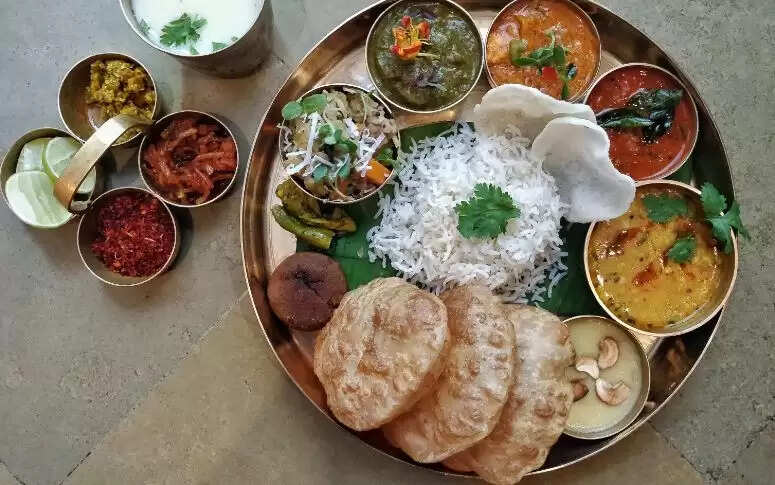
As Maharashtra is a vast state, there are different variations of Maharashtrian Thali found in different regions. A standard Thali usually includes Daal, Rice, Roti, and seasonal vegetables, in addition to the following dishes.
- Sabudana Wada comes as a starter for me, I simply love it
- Varan Bhat – Maharashtrian version of Khichdi
- Amti or the Chana Daal, the Maharashtrian style
- Puran Poli – a favorite Maharashtrian mild sweet dish
- Shrikhand – I am not too fond of Shrikhand, but don’t that to Maharashtrians ????. You get it in various flavors including Mango called Amrakhand.

